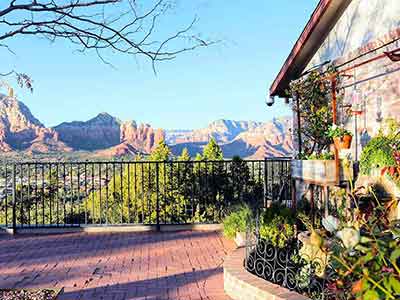Ruins of the Verde Valley
The Sinagua first inhabited the area around the San Francisco Peaks (near of Flagstaff, AZ) around 500 A.D., living a peaceful existence in timber pit houses. Sinagua comes from the Spanish phrase for the area, sin (without) and agua (water). An apt description since they relied solely on rainfall to water their crops.
This was all to change in 1064 A.D. with the eruption of Sunset Crater, which forced them to leave the area. When they returned they found the volcano had deposited ash over 800 square miles, eventually making the soil greatly enriched. What had started out as a disaster had turned into a blessing. This new fertility attracted other more advanced groups—the Anasazi, Mogollon, and Hohokam—and strengthened the trade between them.
The Anasazi were cliff dwellers from the northern areas. Their ruins at Canyon de Chelly and Navajo National Monuments are among the best-preserved ruins found in North America. Their influence can be seen in some of the fine dwellings the Sinagua eventually created in the Verde Valley.
The Mogollon were primarily hunter/gatherers who lived in the mountains in small villages. Ancestors of the Mogollon were the first Southwestern culture to grow corn, which they received from trading parties in Mexico. They were also the first to make pottery, and taught the Sinagua to fashion rough, red pots for cooking and storage. It is generally believed some of the Mogollon were the ancestors of today's Hopi and Zuni tribes.
The Hohokam built a civilization that lasted for about 1700 years. They were the first farmers in the area to exhibit knowledge of irrigation. By the Salt River they dug out over 200 miles of irrigation canals—some 40 feet wide and 15 feet deep. They showed the Sinagua how to irrigate, and make canals.
As the Hohokam moved north to take advantage of the fertile land, some Sinagua moved south into the Verde Valley, beginning their occupation around 1200 A.D. With the new knowledge they had gained from trading and living near these other tribes they soon began to prosper. The Hohokam eventually disappeared like the Sinagua, but it is believed some of their descendants became today’s Pima Indians. Hohokam is a Pima word for “those who have vanished.”
From 1130 A.D. to 1300 A.D., the Sinagua built pueblos of red stone, often hidden deep in red rock canyons. Two of the largest and best-preserved ruins in the Verde Valley—Honanki and Palatki—are good examples of these villages, usually home to groups of related families.
Soon after, the Sinagua began to move to hilltop villages near perennial streams like Beaver Creek and the Verde River. Two of these ruins—Tuzigoot and Montezuma Castle—are National Monuments, and within easy reach of Sedona. Tuzigoot is Apache for “crooked water.”
Montezuma Castle National Monument has two distinct locations: Montezuma Castle and Montezuma Well. Mistakenly named after the famous Aztec leader, both locations are within a few miles of Interstate 17 (about 25 miles from Sedona).
Montezuma Castle has two, five-story pueblos built into the cliffs above Beaver Creek. Montezuma Well is a limestone sink, partially filled from an underground spring that flows at 1.5 million gallons per day. Lime-encrusted remnants of their irrigation ditches are still visible, as is an excavated, twelfth-century Hohokam pit house.
At the height of their civilization there were about 5,000 Sinagua living in the area. They were linked to the north and south by a major trade route called the Palatkwapi trail. By all accounts they seemed to have prospered, but by 1425 A.D. they had abandoned the Verde Valley.
Still, those who visit the area can feel their presence. The Verde Valley is filled with ruins, and not just the ones already mentioned. If you hike along Beaver Creek, or in the western canyons, you will find evidence of the ancient Indians everywhere. Walk into an overhung area, or a cave along one of the rivers, and you will most likely see petroglyphs, adobe ruins, or maybe a pottery shard. DNA evidence may one day explain where they went, but all one has to do is visit a few of these ruins to understand the greatness of their existence here.
Palatki At-a-Glance
Honanki At-a-Glance
Montezuma Castle At-a-Glance
NATIVE AMERICAN ART, CULTURE, & ATTRACTIONS
Pink Jeep Adventures
Family-Friendly | Native Culture & Tours | Professionally Guided
A Day In The West
Western Experience | Family-Friendly | Activities | Native Culture & Tours | Professionally Guided












